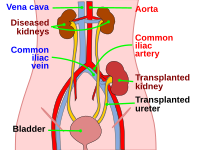
Photo from wikipedia
Introduction: Infectious events are one of the leading causes of death in kidney transplant recipients (KTRs). KTRs have reduced cardiorespiratory fitness (CRF), a predictor for infections in other populations. The… Click to show full abstract
Introduction: Infectious events are one of the leading causes of death in kidney transplant recipients (KTRs). KTRs have reduced cardiorespiratory fitness (CRF), a predictor for infections in other populations. The aim of this study was to investigate whether CRF and muscle strength are prognostic markers for infectious events in KTRs. Methods: In this retrospective cohort study, 155 KTRs underwent an incremental, maximal cardiopulmonary exercise test (CPET) 3 months after transplantation. CRF was analyzed with peak oxygen consumption (VO2 peak) while muscle strength with isometric handgrip (HG) test. Laboratory blood samples and drug therapy were collected. The median follow-up period was 54 (interquartile range 38–62) months. Cox regression analyses were performed to evaluate predictors of infectious events adjusting for potential confounders. Results: During this study, severe infectious events occurred in 41 subjects (26.5%). 15.5% (n = 24) of patients had a severely reduced CRF, defined as a VO2 peak below the 5th percentile of the reference values reported for a matched healthy population. The hazard ratio for infectious events in this subgroup was 2.389 (95% CI = 1.188–4.801, p = 0.014), independently of gender, age, BMI, time on dialysis, hemoglobin concentration, eGFR, diabetes, and immunosuppressive regimen. On the contrary, no significant association of HG strength and infections was found. Conclusion: Therefore, low CRF may be considered as a modifiable predictor of severe infectious events in KTRs. A CPET should thus be recommended for cardiovascular screening, evaluation of CRF, and tailored exercise prescription to reduce the risk of infections and potentially improve long-term outcomes of transplantation.
Journal Title: American Journal of Nephrology
Year Published: 2021
Link to full text (if available)
Share on Social Media: Sign Up to like & get
recommendations!